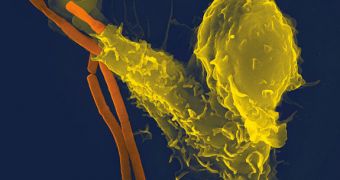Scientists from Australia's Centenary Institute managed to film the way the immune system actually responds to infections in real time, using state-of-the-art modern technology. They watched skin activity for a while, after which time they introduced the Leishmania parasite in the skin and watched how the pathogen spread and what the immune system did to prevent it.
"Using multi-photon microscopy, we studied dendritic cells in the skin. Under normal conditions we found the cells in the epidermis (top layer) were static, whereas in the dermis (second layer) they were very active, moving around as though seeking out pathogens. Once we established this, it was fascinating to introduce the Leishmania infection and watch as the parasite was picked up by the cells and the process by which it began to spread throughout the body," says Professor Wolfgang Weninger, head of the Immune Imaging program at the Institute.
He adds that "We now have a general idea of how pathogens are recognized by the immune system and which cells are involved. This means we can look at identifying the molecules responsible for the uptake of Leishmania infection and these molecules could become vaccine targets. Additionally, we can investigate the immune responses of other infections which could lead to better vaccines."
The disease affects some 12 million people worldwide, mostly in Africa, South America and the Middle East, and it can cause skin soars and even affect internal organs, such as the spleen and the liver. It can be fatal, if left untreated, and a fully-effective vaccine has yet to be devised. The new multi-photon microscopy technique could potentially provide researchers with the same amount of information that orbital Hubble space telescope provided eager astronomers back on Earth.
"The Hubble allowed the universe to be seen with absolute clarity, which wasn't before possible from earth. This is exactly the same as multi-photon microscopy – it provides a unique and innovative view of cells, unveiling a whole new understanding of how immune processes work," concludes Weninger.

 14 DAY TRIAL //
14 DAY TRIAL //